Design and experiment of high-productivity two-stage vacuum pressure swing adsorption process for carbon capturing from dry flue gas
Xiuxin Yu,Bing Liu,Yuanhui Shen,Donghui Zhang
The Research Center of Chemical Engineering,School of Chemical Engineering and Technology,Tianjin University,Tianjin 300072,China
Keywords:Two-stage VPSA process Binary mixture CO2 capture Zeolite 13X Carbon molecular sieve
ABSTRACT A two-stage vacuum pressure swing adsorption (VPSA) process that coupled kinetically controlled and equilibrium controlled separation process with reflux has been investigated for capturing carbon dioxide from dry flue gas (85% N2/15% CO2).In the first enriching stage,carbon molecular sieve (CMS),which shows kinetic selectivity for CO2/N2,is adopted as the adsorbent to remove most N2 in feed gas,thereby upgrading CO2 and significantly reducing the amount for further refinement.The second stage loads zeolite 13X as adsorbent to purify the CO2-rich flow from the first stage for meeting the requirements of National Energy Technology Laboratory.Series of experiments have been conducted for adsorption isotherms measuring and lab-scale experimental validation as well as analysis.The effect of feed composition on the separation performance of the PSA system was studied experimentally and theoretically here.The optimal results achieved 95.1% purity and 92.9% recovery with a high CO2 productivity (1.89 mol CO2.h-1.kg-1) and an appropriate energy consumption of 1.07 MJ.(kg CO2)-1.Further analysis has been carried out by simulation for explicating the temperature,pressure,and concentration distribution at cyclic steady state.
1.Introduction
Recent evidence suggests that human activities have emitted large amounts of carbon dioxide and amplified the global warming effect [1–3] and 40% of the total CO2emissions were produced by fossil fuel combustion [4].Recent developments in global energy demand have heightened the need for a comprehensive portfolio of technologies which include alternative energy,energy-saving systems,and carbon capture,utilization,and storage (CCUS) measures to alleviate the current situation and slow the rise of CO2concentration in the atmosphere,whereas CO2has been proved as an important industrial material and ideal driving agent for enhancing oil recovery (EOR) [5–8].Among the dominant CO2emission sources,power plants have the largest proportion,which accounts for 78.24% and approximately 2 billion tons of CO2were discharged per year[9–11].The flue gas emitted from power plant contains 12%-15% CO2which is difficult to be applied for CCUS[12,13],Therefore,producing high-purity CO2product from the flue gas is of great significance for diminishing greenhouse effect and supplying CO2resource.The process of capturing CO2from a gas stream and storing CO2underground is called CO2capture and storage (CCS),there are several methods for CCS,such as adsorption,absorption,membranes,cryogenic distillation,chemical looping and biofixation [11,14],under the umbrella of postcombustion,pre-combustion and oxyfuel combustion[15].Several processes have been developed and verified by experiments [16–18],the amine scrubbing is the only commercial and mature approach in industrial [19,20].Pressure swing adsorption (PSA) is a highly mature and versatile gas separation and purification technology in the chemical industry as well as a major technology of interest within the field of CCS,due to its lower energy requirements for regeneration than amine scrubbing [21,22].In PSA process,the fluctuation of raw gas quality within the operating range is acceptable,and there is an easier pretreatment process than membrane separation [12,23].In addition,PSA process is highly automatic,thus is favorable for the field application for treating the flue gas [24,25].Therefore,it is necessary to research the technology and develop new processes.
Several one/two-stage PSA processes for post-combustion CO2capture have been compared in Table S1(Supporting Information).One-stage VPSA process is featured with low equipment investment and easy operation.Haghpanah et al.investigated a 2-bed-4-step process by using zeolite 13X as the adsorbent and the simulation results indicated that both the recovery and purity of CO2exceed 90%and energy consumption was 0.536 MJ.(kg CO2)-1with a productivity of 1.27 mol CO2.h-1.kg-1at optimal conditions[26].Yan et al.proposed a dual-bed-five-step VPSA mathematical model to validate the accuracy of the model by experiments[27].In their study,silica gel was the adsorbent and CO2obtained 90.8% purity and only 76.6% recovery while the energy consumption and productivity reached 1.51 MJ.(kg CO2)-1and 2.23 mol CO2.h-1.kg-1,respectively.Krishnamurthy et al.carried out a pilot study to verify the actual performance of zeolite 13X [28] and CO2was concentrated to(94.8±1.0)%purity with a recovery of(89.7±5.6)%,while the energy consumption was ((1.22–2.10)±0.132) MJ.(kg CO2)-1and the productivity was ((1.23–1.98)±0.099) mol CO2.h-1.kg-1.Nikolaidis et al.established two one stage VPSA processes with 13X and Mg-MOF-74 as adsorbent respectively,the energy consumption is 1.749 and 2.158 MJ.(kg CO2)-1for each one when the purity and recovery of CO2both are 90%.The dual-reflux VPSA process(DR-VPSA)have been applied for CO2capture from dry flue gas.Li et al.simulated a 2-bed-6-step dual-reflux VPSA process that adopted silica gel as adsorbent[29].The results show that both the purity and recovery of CO2in product gas reached 99.6%,but the energy consumption was high(1.94 MJ.(kg CO2)-1)and productivity was relatively low(1.81 mol CO2.h-1.kg-1).For one-stage VPSA process,the trade-off between purity and recovery is a main downside in the application for CCUS from dry flue gas,because it could be difficult to reuse purge/displacement gas,which means the recovery and purity might not be satisfied at the same time.

Table 1 Schedule of the first stage process

Table 2 Schedule of the second stage process
In two-stage process,it is feasible to reuse or recycle streams from a stage to another for further purification to achieve both high recovery and purity because of the coupling between two stages.Liu et al.presented a two-stage VPSA process used 13X attaining 96.05%purity and 91.05%recovery of product gas.The overall productivity was 0.646 mol CO2.h-1.kg-1with an energy consumption of 0.33 MJ.(kg CO2)-1[30].Wang et al.simulated a two-stage VPSA process that achieved 96.54%purity and 93.4%recovery,the energy consumption was reduced to 0.710 MJ.(kg CO2)-1,but the productivity was only 0.53 mol CO2.h-1.kg-1while zeolite 13XAPG was adopted as the adsorbent in both stages [31].In their following work,a plant-scale research and a detailed investigation of the actual production energy consumption was conducted.The results showed that the energy consumption was 2.44 MJ.(kg CO2)-1with a purity of 95.6%and recovery of 90.2%while the productivity was up to 0.74 mol CO2.h-1.kg-1[32].Nikolaidis et al.simulated and optimized a two-stage P/VSA process by using 13X adsorbent in the first stage and MgMOF-74 adsorbent in the second stage.The simulation results showed that the purity of CO2was 97.6% with a recovery of 90.2% and the energy consumption was only 0.700 MJ.(kg CO2)-1while the productivity was large,about 3.09 mol CO2.h-1.kg-1[33].Jiang et al.established 2-bed-6-step followed 2-bed-5-step process with 13X as adsorbent,which could produce 3.8 mol CO2.h-1.kg-1with purity of 96.03% and recovery of 91.86% under the energy consumption of 0.79 MJ.(kg CO2)-1.
PSA processes based on the inherent adsorption selectivity can be divided into two main categories:equilibrium and kinetically controlled processes.In previous research,plenty of equilibrium controlled PSA processes had been proposed,such as biogas separation for CO2capture on silica gel [34],hydrogen production on activated carbon (AC) and zeolite 5A [35],but the kinetically controlled CO2capture process in field scale is less.The PSA processes based on kinetic separation use differences in the mass transfer rates of different adsorbates.In CO2/N2separation on carbon molecular sieve (CMS) process,the faster-diffusing component(CO2) has advantages of equilibrium because of the higher diffusional rate[36].CMS is a typical kinetic-separation adsorbent characterized by a large productivity [37].The feature of kinetic PSA process indicates a great potential for CO2capture in large-scale separation.Haghpanah et al.reported a two-staged kinetically controlled CO2capture processes for handling post-combustion flue gas which CMS was applied as adsorbent in both stages.They found that when the target of CO2purity was set below 60%,the recovery and energy consumption values were superior.If the tar-get of CO2concentration was set to >80%,its recovery and energy consumption values would quickly deteriorate with purity rising[36].Therefore,it is seemingly integral to introduce an equilibrium controlled separation after a kinetically controlled one to form a multi-stage process:CMS is selected as adsorbent for the first stage process to enrich CO2to 50%-60% and the adsorbent with high selectivity,zeolite 13X,which has a low capture cost [38] and is widely used in the separation of dry flue gas by pressure swing adsorption [24,28,39,40],is adopted in the second stage process to further purify CO2to 95%.
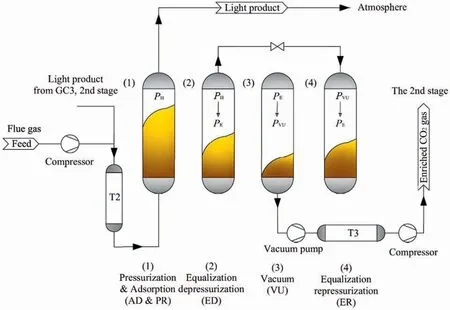
Fig.1.Schematics of steps in the first stage process.
The primary aim of this paper is to assess the feasibility of the PSA process which combined kinetically controlled and equilibrium controlled separation process for CO2capture with high productivity.In this work,a special two-stage VPSA process which had a light-component reflux has been investigated to verify the feasibility of above idea.A certain amount of adsorbent was saved by applying kinetic PSA process in the first stage.In the second stage,zeolite13X was employed to refine CO2to 95%so that purity standard of National Energy Technology Laboratory (NETL) could be satisfied [41].Mathematical model was established and validated by the experiments.The discuss and analyses of the dynamic and transmitted behaviors of the process which are difficult to directly measured by experiments have been implemented under the optimal conditions by simulation was operated to analyze this process,such as the temperature and component distribution in beds.
2.Process Operation Strategy
2.1.The first stage process
The first stage process consists of two adsorption beds packed with CMS,a vacuum pump,and a compressor.As displayed in Table 1,the schedule of the first stage process is 2-bed-4-step,and the schematic of each step is shown in Fig.1.The pressurization(PR)and adsorption(AD) step are coupled together for a total of 50 s to reduce the number of steps and simplify the device.The diagram of PLC control nodes of solenoid valves is shown in Fig.S1.In this step,dry fuel gas and light product of the second process are compressed and pass through Bed 1/Bed 2 from bottom,and most CO2is adsorbed while N2is exhausted to atmosphere from top.The equalization depressurization (ED) and repressurization (ER) step are performed simultaneously in a cycle for higher recovery.In ED/ER step,because of the connection of two beds,the gas flows from the higher-pressure bed to the lower-pressure one,which render these two beds almost have the same final pressure.In vacuum (VU) step,CMS is regenerated while bed pressure decreases sharply,and majority of adsorbed CO2is desorbed and recovered.
2.2.The second stage process
The second stage process consists two adsorption beds which load zeolite 13X as adsorbent,a vacuum pump,and a compressor.The schedule of the second stage process is 2-bed-5-step,as set out in Table 2 and the sketch of each step in the second stage is presented in Fig.2.There is an independent PR step in the second stage process,because the adsorption capacity at zeolite 13X is greatly influenced by pressure.The heavy product gas is injected into the second stage as feed gas and the source for pressurization in PR step.In AD step,the light product is refluxed to the first stage process as feed in order to improve the recovery because of the large flux and the CO2concentration about 15%.ED/ER and VU steps in the second stage are almost identical to those in the first stage.In addition,the operation of two stage is coupled and the detailed step schedule and working state are displayed in Table S2 and Figs.S2–S13.
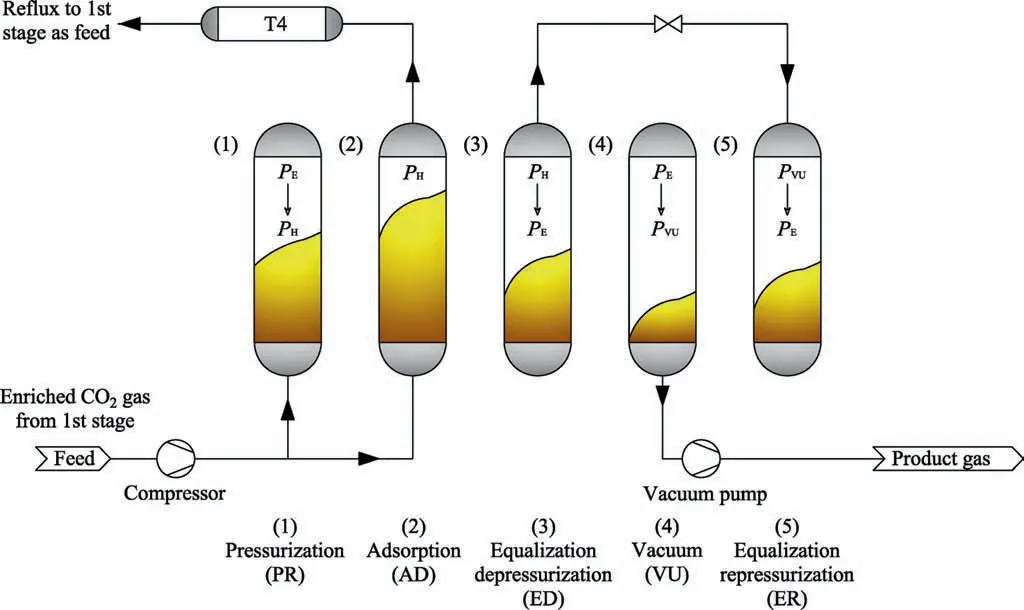
Fig.2.Schematics of steps in the second stage process.
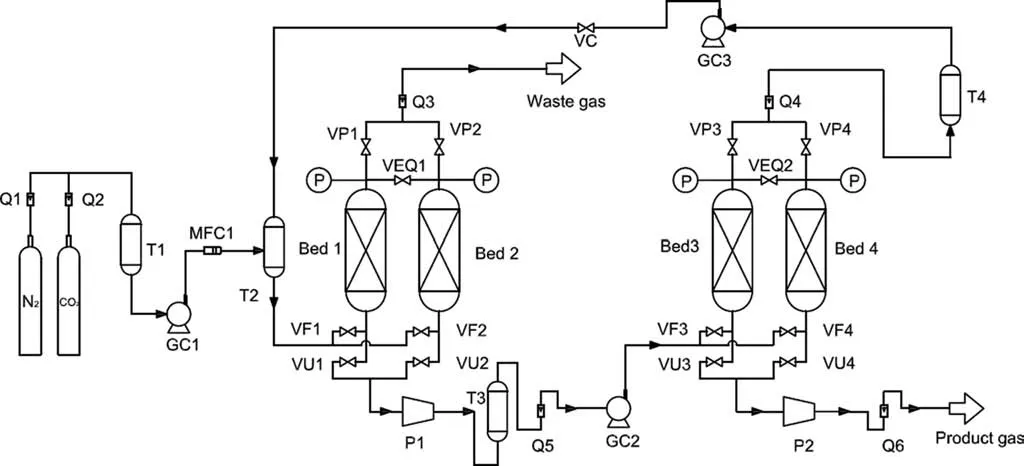
Fig.3.Flowchart of the two-stage VPSA experimental device.(T1-T4,buffer tanks;VF1-VF4,VP1-VP4,VU1-VU4,VEQ1-VEQ2,VC,solenoid valve;Bed1,Bed2,adsorption bed;MFC,mass flow controller;P,pressure gauge;GC1-GC3,gas compressor;P1,P2,vacuum pump;Q1-Q6,rotor flowmeter).
3.Experiment Apparatus
The experiment work was shown below:(1) A set of two-stage PSA device has been built;(2)The adsorption isotherms were measured;(3)Several groups of univariate experiments have been carried out to investigate influence of feed fluctuation.
The apparatus of the two-stage VPSA process is drawn as Fig.3.The pure gases are transported and mixed in T1.Pump GC1/2,as the feed pump,pressurize and feed the gas in T1/3 to adsorption bed in two stages,respectively.The gas in bed 1/2 was extracted and stored in T3 with vacuum pump P1 working,and P2 is the same of the second stage.In addition,light product which would be discharged from top of bed 3/4 is stored in T4 and recycled to tank T2 by pump GC3.
The feed gas is mixed with N2(99.99%) and CO2(99.99%) provided by Tianjin Summit Specialty Gases Ltd.The volume of the gas buffer tanks are 5L and the solenoid valves(Chongqing oriental solenoid valves factory)are used to perform automatic control.Mass flow controllers (MFCs),supplied by Chengdu Laifeng China,are adopted to control the feed flow rate with the uncertainties of 0.200% of the full scale.Pressure gauges are offered by Shanghai Sighto Instrument Co.,China and the uncertainty of the PGs is 1%of the full scale.Two diaphragm pumps (P1,P2,ULVAC DAT-500 type,Japan) are applied on evacuating the column at the designed vacuum pressure level and three gas compressors (Fujian Juba BX2025 type,China)are used to transport gas.A gas chromatograph(Beijing Ruili’s SP2100A type,China) with a thermal conductivity detector(TCD)is placed at the gas sampling port to analyze composition and concentration of gas online.Six rotameters(Suzhou Chemical Instrument Co.,Ltd’s LZB-6,China)are installed to observe the flow of gas.The time schedule is controlled by SIMATIC S7-200CN PLC.The accuracy of flowmeters and sensors is detailed in Table S3.
4.Measurements of Equilibrium Isotherms
Reliable adsorption equilibrium data constitute the key elements for PSA process.The adsorption isotherms describe the variation of saturated adsorption capacity (qi*) with different temperature and pressure,which are critical to simulation results.The saturated adsorption capacity of CMS and zeolite 13X has been measured by static volumetric method [42,43],and the schematic chart of apparatus is shown as Fig.S14.The adsorption isotherm of CO2/N2mixture on zeolite 13X is predicted by the multisite Extended Langmuir 2 model(Eq.(1))[33]while that on CMS is represented by multisite Langmuir isotherm [39] as Eq.(2).
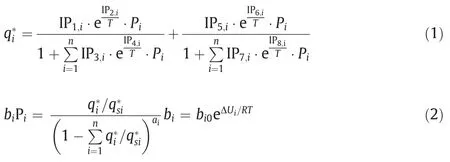
where IP1-8,iare the isotherm parameter of component i,Piis partial pressure of component i,T is the gas temperature,qi*is saturated adsorption capacity,ai,bi0,ΔUiare constant related to the adsorption isotherm.
The results of experiment and fitted isotherms are demonstrated as Fig.4 and Fig.5 while the parameters are displayed in Table 3.Fig.6 shows the calculated adsorption amount based IAST for each component in N2and CO2mixture at the molar fractions,CO2:N2=54.1:45.9,the inlet gas of stage 2,as well as the selectivity of the mixed gases on the zeolite 13X.Average relative deviation,as shown in Eq.(3),is introduced to evaluate the fitting results.

Table 3 Fitting parameters of N2 and CO2 on CMS and 13X
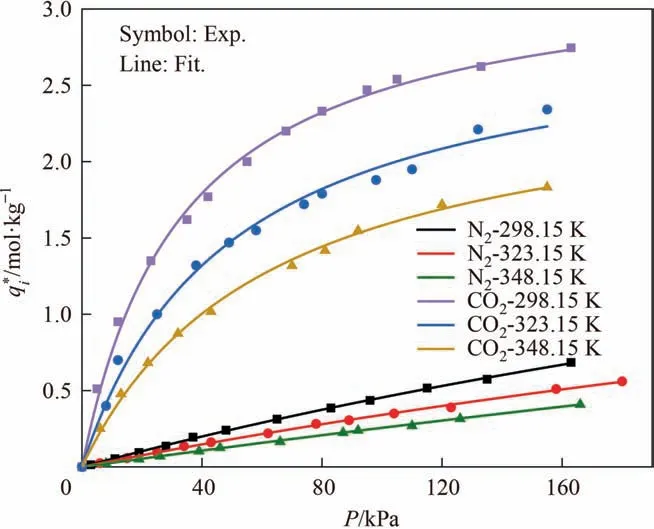
Fig.4.CO2 and N2 adsorption isotherms on CMS.
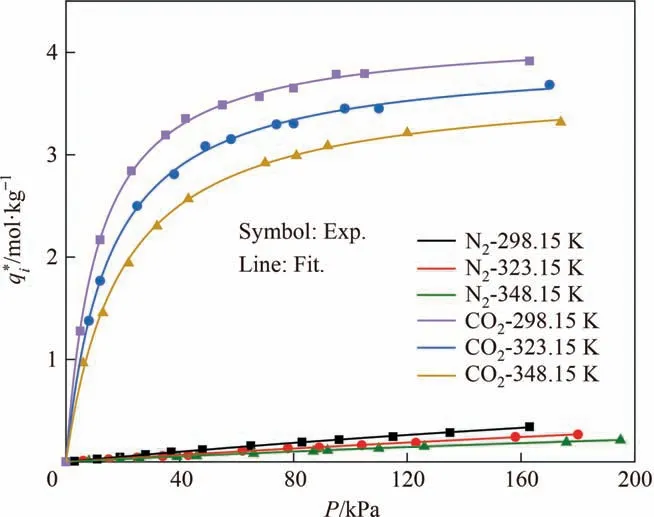
Fig.5.CO2 and N2 adsorption isotherms on zeolite 13X.

Niis the number of data points in experiment,is the real value measured by experiments whileis obtained by fitting.
5.Mathematical Model
V/PSA is typical dynamic process,and an accurate mathematical model is critical to the variable description over a cycle.An integral mathematical model includes mass,energy,and momentum balances with the boundary conditions over a cycle.Several assumptions are made to reduce the amount of computation and listed as follows [44,45]:
(1) The gas phase is considered as an ideal gas.
(2) There is no radial variation in the gas concentration,temperature,and pressure.
(3) The pressure drop in adsorption bed is conformed to the Eugen equation.
(4) The bulk flow and adsorbents are in thermal equilibrium.
(5) A linear driving force (LDF) model is used to describe the inter-phase mass transfer resistances.
(6) Porosity of beds and adsorbent particle is uniform along the adsorption bed.
Based on above assumptions,a number of equations are composed to simulate the PSA process,summarised in Table S4,and the boundary conditions of each step are illustrated in Table S5[39,46–49].The upwind differencing scheme1(UDS1)was applied to solve the partial differential equations (PDEs) with 40 discretized nodes per bed and a 10-5precision for absolute tolerances.The minimum time interval is 0.1 s.
A set of breakthrough experiment has been carried out to validate this mathematical model,the conditions are summarised in Table 4.The height and diameter of the adsorbent bed used were 1 m and 0.1 m,respectively.The feed flowrate is kept constant by mass flow controllers (MFC),and the back pressure valve at the top of beds controls the pressure in the adsorption bed.Three temperature sensors are embedded in the position distribution of 0.05,0.5 and 0.95 m in the adsorbent bed.The behaviors of temperature and breakthrough curve of case 6 &9 are presented in Fig.7.The breakthrough time at CMS is 98 s,much shorter than zeolite 13X,485 s,and the simulation data is in good agreement with the experimental results.Because of the hysteresis of temperature conduction,the experiment data are not completely consistent with the simulation results while the trends of the two results are basically the same.Generally speaking,the accuracy of this mathematical model has been verified.Moreover,detailed description of breakthrough experiment and all the results are displayed in Table S6 and Fig.S15-16.
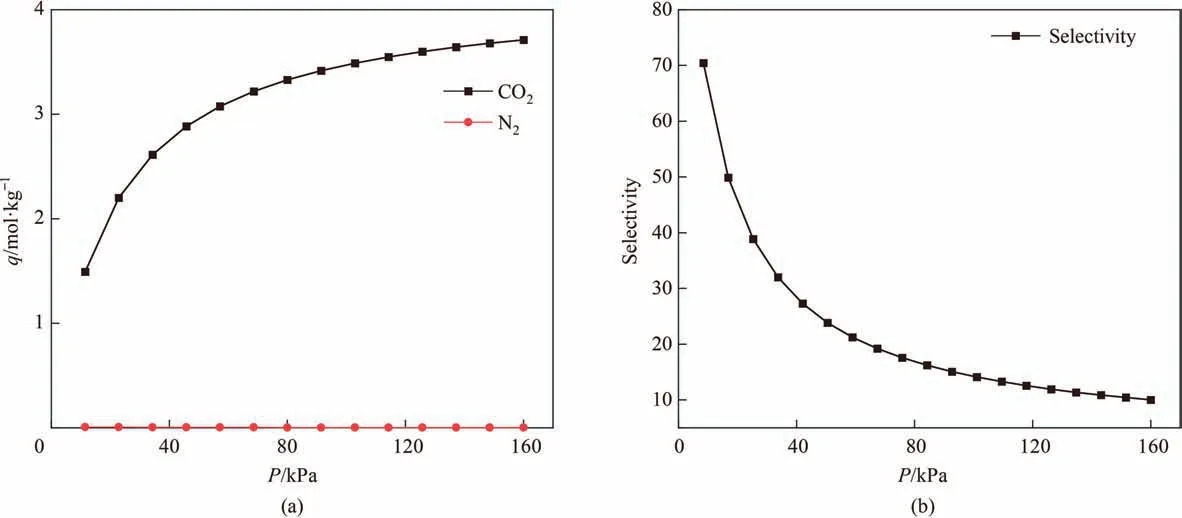
Fig.6.(a) Calculated adsorption amount for each component in N2 and CO2 mixture;(b) Adsorption selectivity of CO2 to N2 (CO2:N2=54.1:45.9,298 K).

Table 4 Conditions of breakthrough experiments

Fig.7.Behaviors of breakthrough experiments.((a)and(b)are the breakthrough curve and temperature variety in three heights of case 6;(c)and(d)are set out for case 9).
Adsorbent parameters are shown in Table 5 and the information of feed and bed is displayed in Table 6.Purity,recovery,and productivity were calculated by Eqs.(4)-(6),respectively.
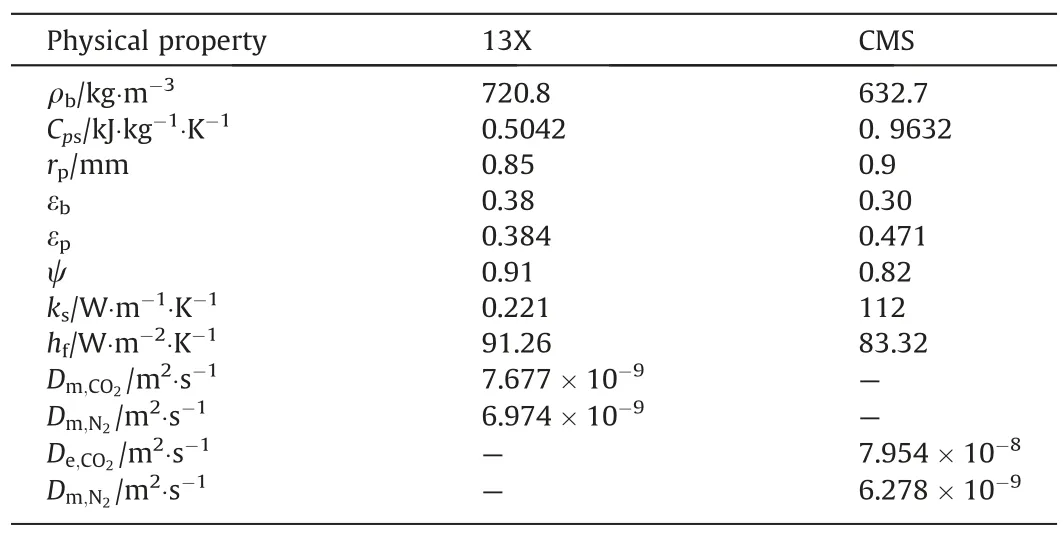
Table 5 Parameters of carbon molecular sieve and zeolite 13X

Table 6 Parameters of bed and feed gas.

PurityCO2is the CO2purity in product gas while RecoveryCO2is the recovery of CO2.tVU,1stand tVU,2ndare the time of VU step in first and second stage process,respectively.Fout,1st/Fout,2ndis the flow rate of heavy product in the first/second process.yout,CO2,1standyout,CO2,2ndare respectively correspondent with the CO2volume fraction of heavy product in the first and second process,Fin,1stis the feed flow rate of the first stage process and yin,CO2,1stis the CO2volume fraction of feed in the first stage process,tcycle,1stand tcycle,2ndare the cycle time of the first and second stage process,respectively.wads,iis the amount of adsorbent used in the stage i process,nsis the number of stages in the process,nb,iis the number of beds in stage i.
When calculating the energy consumption,the efficiency of the pump is considered,but the energy loss of pipeline and valve is neglected in energy consumption model.The instantaneous energy consumption of pumps within each time node is calculated as Eq.(7).The total energy consumption of the whole apparatus is shown in Eq.(8).The energy-consumption-calculation method for capturing unit CO2is expressed as Eq.(9).
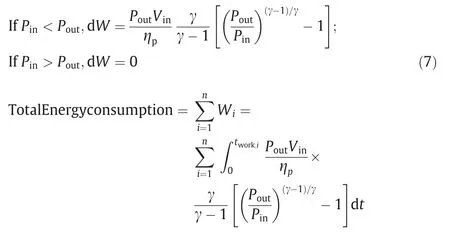

In the above equation,ηpis the polytropic efficiency,γ is the polytropic constant and dW is the instantaneous power consumption,Vinis the inlet volumetric flowrate of the gas mixture,Pinis the pressure of pump inlet and Poutis the pressure of pump outlet,Wiis the energy consumption of pump i,twork,iis the working time of pump i in a cycle.
In addition,the determination of cyclic steady state (CSS) are shown in Supplementary Material.
6.Results and Discussion
6.1.Experimental results
The excellent agreement of the simulations and experimental results confirmed the accuracy of the model of adsorption bed,the PSA model verification will be examined by the performance.In this section,three series of single-variable experiments(composition,temperature,and flow rate of feed gas) have been implemented for further verifying and the feasibility of the design,because these parameters are usually fluctuating with power generation,coal quality and environment temperature.The value of purity and recovery are measured by simulation and experiment,and productivity and energy consumption are calculated by simulation,the results are shown in Table 7.
6.1.1.Effect of feed composition
The effects of feed composition are shown in Table 7(Runs 1-5)and Fig.8.The results indicate that CO2purity increases from 92.31% to 95.63% while the recovery of CO2decreases from 93.61% to 92.18% when the CO2content of feed rises from 12% to 16%.The simulations show good agreement with experimental.The CO2concentration in gas–solid phase raises with the increase of CO2in feed gas,and the adsorption front gradually moves toward the top of bed,as displayed in Fig.9,which causes more CO2breakthrough and reduces the recovery but raises the purity.The output power of pumps could be regarded as constant since the feed flow rate and desorption conditions have not changed.As the quality of the feed gas increases,the flow rate of CO2emitted from bottom increases and the energy consumption reduces,which means a higher productivity because of the constant mass of adsorbents.

Table 7 Results of experiment and simulations.
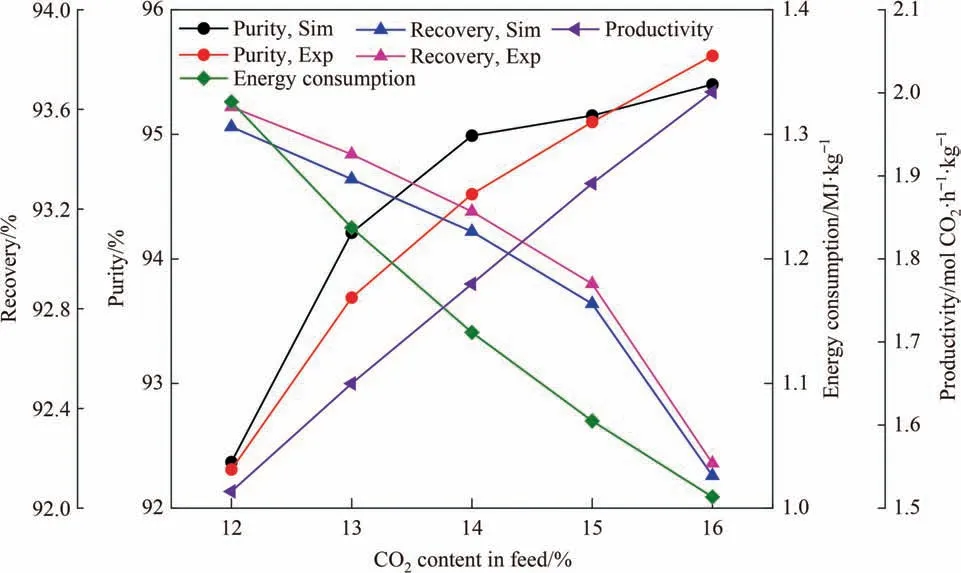
Fig.8.Effect of feed composition on process behaviors.
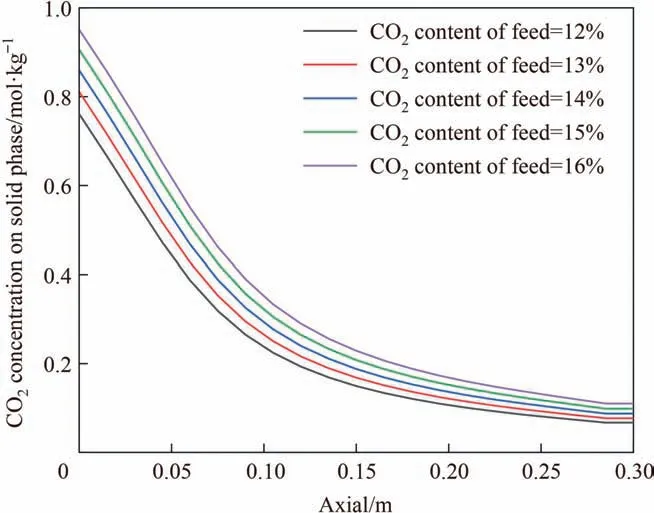
Fig.9.CO2 Solid-phase concentration of the first stage process.
6.1.2.Effect of feed temperature
The effect of feed temperature on apparatus performance is demonstrated by Runs 1,6–8 in Table 3 and Fig.10.When feed temperature increases from 298.15 K to 313.15 K,the CO2purity decreases from 95.10% to 94.39% while the recovery rises from 92.90% to 94.57%.Higher temperature would undoubtedly lead to the decrease of CO2adsorption capacity during AD step but be helpful for regeneration of adsorbents in VU step.The above two effects are opposed and the final direction of above two effects is determined by working capacity change which is the difference of CO2solid-phase concentration between the end of AD and VU step.Fig.11 displays the effect of feed temperature on working capacity of adsorbents in the first stage.To a certain extent,298.15–313.15 K of this system,higher bed temperature would make adsorbent regenerate more thoroughly and adsorb more heavy components during next AD step,which would contribute to the increase of CO2recovery.With the increase of adsorbent working capacity,the energy consumption is reduced and the productivity is increased.Based on the above discussion,the increase of feed temperature could improve the performance within the scope of study,but the effect on the results is slightly as the other two variables.
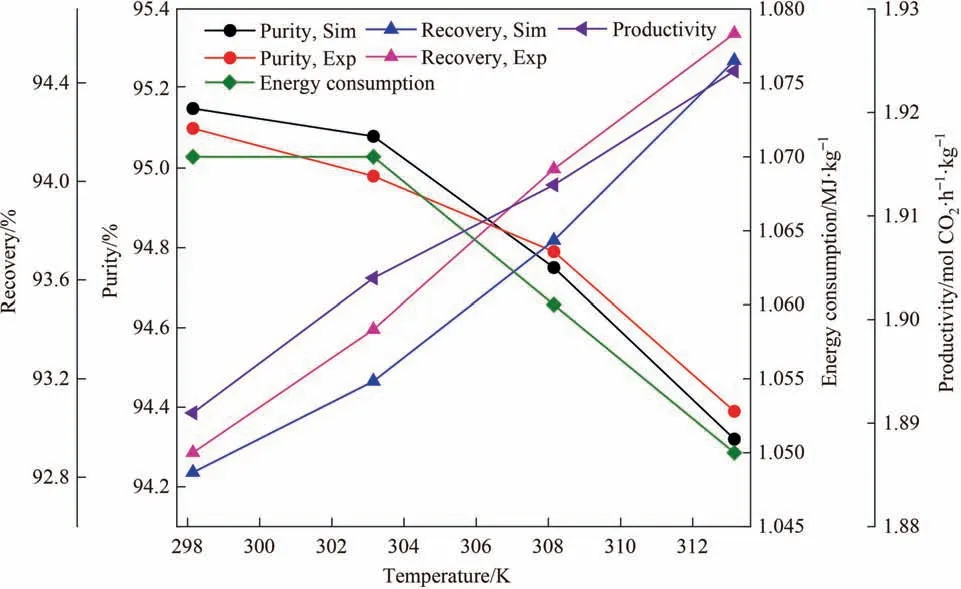
Fig.10.Effect of feed temperature on purity and recovery.
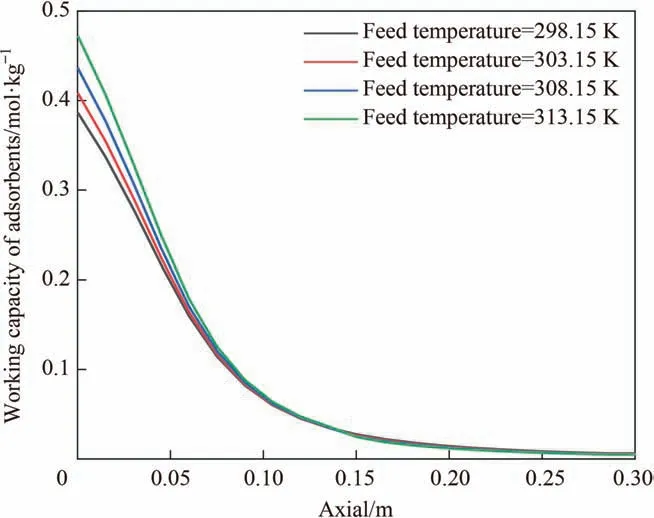
Fig.11.Effect of feed temperature fluctuation on working capacity.
6.1.3.Feed flow rate
The effects of feed flow rate on process performance are shown as Run 1 and Runs 9–11 in Table 7 and Fig.12.The results illustrate that CO2purity of product increased from 95.10% to 95.98% while the recovery of CO2decreased from 92.9%to 88.31%with feed flow rate raising from 19.4 to 22.4 L.min-1.When the feed rate increases,more CO2is accumulated in the gas-solid phase of bed,but the adsorption front continuously moves forward,as displayed in Fig.13,which causes more CO2breakthrough in AD step and the CO2recovery is reduced.So,the effect of increasing feed flow rate is similar to the influence of raising the CO2proportion of feed gas.It is not an economic operation since the energy consumption performance is deteriorating sharply as shown in Fig.14.
6.2.Analysis of the two-stage VPSA process by simulation
In this part,the discussion of process parameters relies on the data provided by simulation.Run 1 in Table 6 is selected as example to analyze pressure profiles,material balance and temperature distribution.
6.2.1.Pressure analysis
Fig.15 displays the pressure profile of bed under cyclic steady state in a cycle.The simulations show good agreement with experimental.The adsorption pressure of the first stage and the second stage is 0.12 MPa and 0.14 MPa,respectively.The pressure of VU step in these two stages are both 0.01 MPa,the lowest value that industrial pumps could achieve.In the first stage process,a low pressure in VU step could reduce the overall CO2loss rate while the purpose for setting the second stage process’s desorption pressure to 0.01 MPa is to make zeolite 13X fully desorbed.The pressure of bed at the end of ED/ER step in the first stage is 0.065 MPa while that in the second stage is 0.07 MPa.
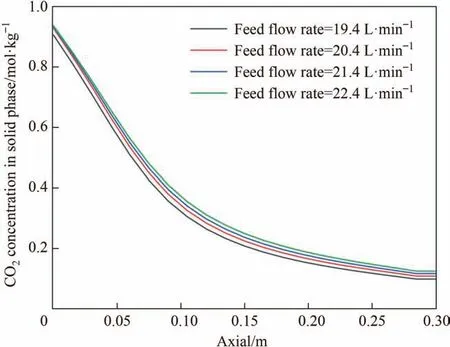
Fig.13.CO2 solid-phase concentration of the first stage process.
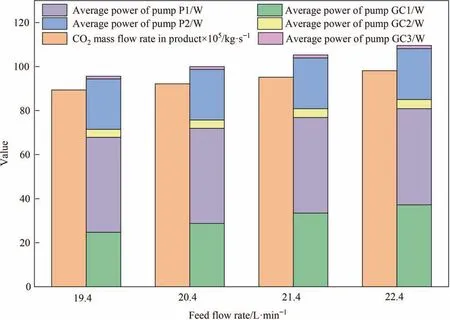
Fig.14.Average power of pumps and CO2 mass flow rate.
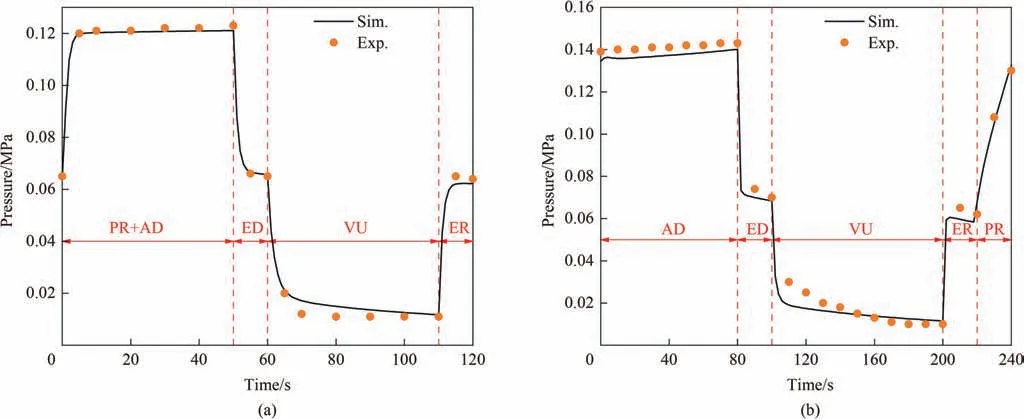
Fig.15.Pressure profile of the two-stage process.((a) the first stage;(b) the second stage).
6.2.2.Temperature and CO2concentration in solid phase
The diagram(a),(b)in Fig.16 shows temperature and CO2solidphase concentration distribution of Bed 1 and the diagram (c),(d)displays those of Bed 3.In the first stage,the maximum temperature (309 K) occurred at the bottom in AD step and the minimum temperature (299 K) appears at the bottom in the end of VU step.In the second stage,the maximum and minimum temperature are 318 K and 294 K,respectively,larger fluctuation range than the first stage.During the AD/PR+AD step,a large amount of adsorption heat is released,and temperature rises rapidly along the bed.The adsorbent at bottom adsorbs the most CO2,so the temperature is relatively higher here than other places.The gas phase is sucked out by vacuum pump and the pressure in the bed is rapidly reduced to 0.01 MPa in VU step,which desorbs a large amount of CO2.Desorption is an endothermic process,so temperature in the bed decreases dramatically.The saturated adsorption capacity and adsorption heat of zeolite 13X is much higher than that of CMS.Thus,the thermal effect in AD step and VU step at the second stage process is higher than those at the first stage process.
6.2.3.Material balance analysis
A complete material balance has been collated in Fig.17.The kinetically controlled separation is significant,and a small amount of adsorbent in the first-stage process completes the preliminary CO2enrichment,from 15%to 54.1%.An equilibrium controlled process for refinement followed by the first stage only treats a quarter of the feed amount (5.83 L.min-1) deeply purifies the heavy product from 54.1% to 95.1%.Although the purity reaches the target,the overall recovery rate (80.6%) has not met the requirements of NETL (>90%).The light product of the second stage process accounts for about 13.3% of the total feed and is recycled to the inlet of the first stage to improve recovery.The reflux operation would weaken the process’s productivity and energyconsumption performance but raise the overall recovery to 92.9%,which is 2.9% higher than the target.The CO2productivity is 1.89 mol CO2.h-1.kg-1.Detailed calculation method for productivity is provided in supporting information.In the first stage,the energy consumption of feed pump (GC1) and vacuum pump (P1)are 0.278 and 0.482 MJ.(kg CO2)-1,respectively.In the second stage,the energy consumption of feed pump (GC2) and vacuum pump (P2) are 0.041 and 0.257 MJ.(kg CO2)-1while that of the pump (GC3) for gas cycle is only 0.013 MJ.(kg CO2)-1,displayed in Fig.18.The total energy consumption is 1.07 MJ.(kg CO2)-1which is primarily used for adsorbent regeneration.

Fig.16.PSA process behaviors over a cycle at CSS.((a)and(b)temperature distribution and CO2 concentration in solid phase of Bed1 in the first stage;(c)and(d)the second stage).
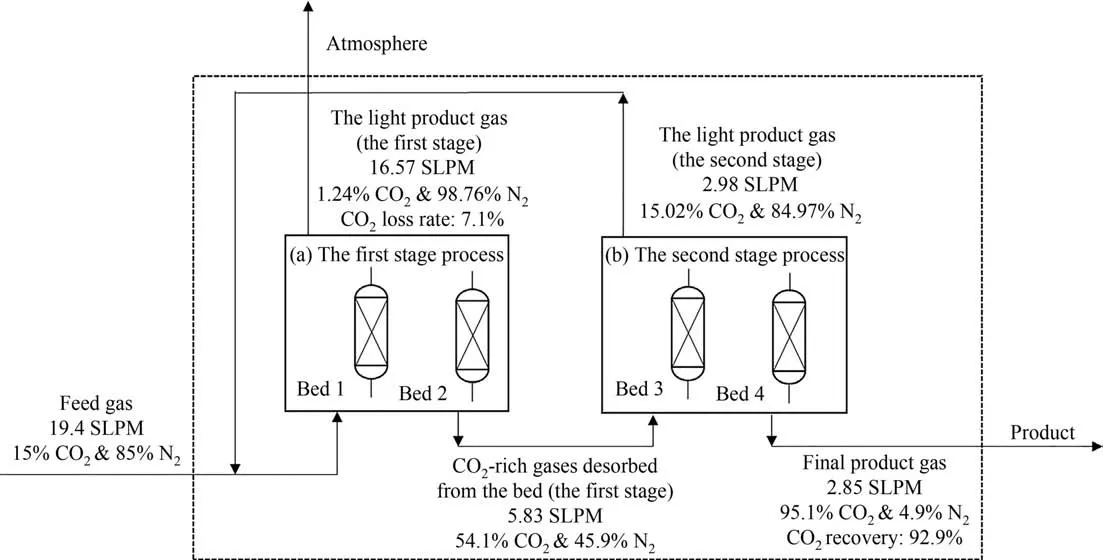
Fig.17.Composition and flow rate of streams.
7.Conclusions
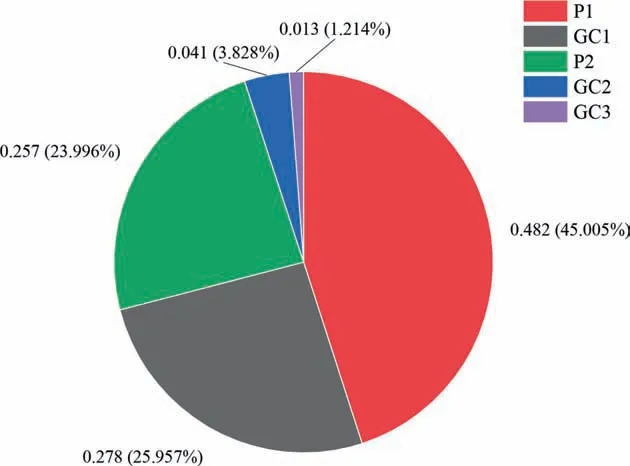
Fig.18.Energy consumption of each device.
A systematic experiment and simulation for CO2capture from dry flue gas by two-stage vacuum swing adsorption process has been demonstrated and discussed,where the two stages in this process are different separation category.The first stage,kinetically controlled separation,removes most of the N2from the dry flue gas,which enriches CO2to 54.1% and substantially reduces the amount of subsequent processing.The equilibrium controlled separation is applied in the second stage and achieved 95.1%purity and 92.9%recovery.The process has large productivity with application of carbon molecular sieve,up to 1.89 mol CO2.h-1.kg-1,and an appropriate energy consumption of 1.07 MJ.(kg CO2)-1.Since zeolite13X with highly selectivity is adopted in the second stage,the purity of product gas reaches the target value (>95%).The whole process has a mild operating condition and the pressure over a cycle varies smoothly,with a maximum of 0.14 MPa in the second stage process’s adsorption step and a minimum of 0.01 MPa at vacuum step.The maximum temperature difference in the first and second stage processes are 10 K and 20 K,respectively.In addition,three series of single-variable laboratory-scale experiments prove the accuracy of simulation.Within the range of error,the experiment results show satisfied agreement with the simulation results.
Declaration of Competing Interest
The authors declare that they have no known competing financial interests or personal relationships that could have appeared to influence the work reported in this paper.
Acknowledgements
This research is financially supported by the Renewable Energy and Hydrogen Projects National Key Research&Development Program of China (2019YFB1505000).
Supplementary Material
Comparison of several processes (Fig.S1),PLC control nodes(Fig.S1),Process steps (Fig.S2-S13 and Table S2),Accuracy of the devices (Table S3),Apparatus for the static volumetric method(Fig.S14),Detailed mathematical model of PSA system and boundary conditions of each step (Table S4 &S5),Breakthrough experiment (Fig.S15-S16 and Table S6),Detailed calculation method.Supplementary data to this article can be found online at https://doi.org/10.1016/j.cjche.2021.02.022.
Nomenclature
ARE average relative deviation,%
aiconstant related to the adsorption isotherm
b0,iconstant related to the adsorption isotherm,MPa-1
Cp,wspecific heat of wall,kJ.kg-1.K-1
Cpsspecific heat of adsorbent,kJ.kg-1.K-1
Cvgspecific heat of gas,kJ.kg-1.K-1
ciconcentration of component i in gas phase,mol.m-3
Dax,iaxial diffusivity coefficient of component i,m2.s-1
Dbdiameter of adsorption bed,m
De,ieffective diffusion coefficient of component i for micropore,m2.s-1
DK,iKnudsen diffusion coefficient of component i,m2.s-1
Dm,imolecular diffusion coefficient of component i,m2.s-1
eCSSabsolute error of two adjacent cycle control variables
F molar flow rate of gas,mol.s-1
Finmolar flow rate of gas at inlet,mol.s-1
Foutmolar flow rate of gas at outlet,mol.s-1
Hbheight of adsorption bed,m
ΔHiisosteric heat of adsorption of component i,kJ.mol-1
hambconvective heat transfer coefficient between wall and environment,W.m-2.K-1
hfconvective heat transfer coefficient between gas and adsorbent,W.m-2.K-1
hwconvective heat transfer coefficient between gas and wall,W.m-2.K-1
IP1,iextended Langmuir 2 model of component i,mol.kg-1-.MPa-1
IP2,iextended Langmuir 2 model of component i,K
IP3,iextended Langmuir 2 model of component i,MPa-1
IP4,iextended Langmuir 2 model,of component i,K
IP5,iextended Langmuir 2 model of component i,mol.kg-1-.MPa-1
IP6,iextended Langmuir 2 model of component i,K
IP7,iextended Langmuir 2 model of component i,MPa-1
IP8,iextended Langmuir 2 model,of component i,K
kgeffective axial thermal conductivity of gas phase,W.m-1-.K-1
kLDFLDF rate constant of component i,s-1
kseffective axial thermal conductivity for solid phase,W.m-1.K-1
ks,ithermal conductivity of adsorbent i,W.m-1.K-1
Miaverage molecular mass of gas i,kg.mol-1
N number of cycle iterations
nb,inumber of bed in stage i
nsnumber of stages in the process
P pressure,Pa
Peenvironmental pressure,Pa
Pfpressure of feed gas,Pa
Pinthe gas pressure on inlet side of valve,Pa
Poutthe gas pressure on outlet side of valve,Pa
Poutletthe pressure at the exit,Pa
Q volume flow rate of gas,m3.s-1
QFvolume flow rate of feed gas,m3.s-1qiadsorbed phase concentration of component i,mol.kg-1
R ideal gas constant,J.mol-1.K-1
Rbradius of adsorption bed,m
rpradius of adsorbent particle,m
T temperature,K
Tambtemperature of ambient temperature,K
Tftemperature of feed gas,K
Tgtemperature of gas phase,K
Tstemperature of adsorbent,K
Twtemperature of wall,K
T0temperature of inside wall,K
t time,s
tcycletime of a single cycle,s
tVUtime required for VU step,s
ΔUiconstant related to the adsorption isotherm,kJ.mol-1
vgsuperficial velocity of gas,m.s-1
W instantaneous power consumption,W
Wswall thickness,m
wads,iamount of adsorbent used in the stage i process,kg
Xtcyclic steady-state control variable
Yf,imolar fraction of component i in feed gas
yimolar fraction of component i
yin,CO2volume fraction of CO2in inlet gas
yout,CO2volume fraction of CO2in outlet gas
z axial direction
εbbulk phase porosity
εCSScontrol accuracy of cyclic steady state
εpparticle phase porosity
γ polytropic constant
ηppolytropic efficiency
μ viscosity of gas,Pa.s
ρgdensity of gas,kg.m-3
ρpdensity of adsorbent particle,kg.m-3
ρsdensity of adsorbent,kg.m-3
ρwdensity of wall,kg.m-3
τ tortuosity of pore in adsorbent particle
ψ shape factor of adsorbent particle
Subscripts
i species
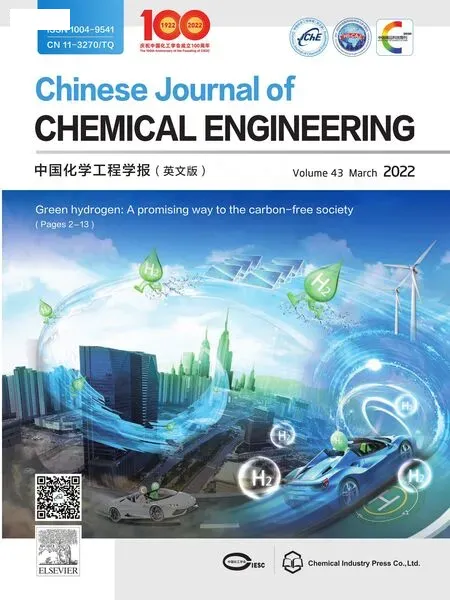 Chinese Journal of Chemical Engineering2022年3期
Chinese Journal of Chemical Engineering2022年3期
- Chinese Journal of Chemical Engineering的其它文章
- Editorial for special issue on Carbon-neutrality Chemical Engineering
- 3D multiphase flow simulation of Marangoni convection on reactive absorption of CO2 by monoethanolamine in microchannel
- Top-down strategy for bamboo lignocellulose-derived carbon heterostructure with enhanced electromagnetic wave dissipation
- Structural reconstruction of Sn-based metal–organic frameworks for efficient electrochemical CO2 reduction to formate
- The effect of different Co phase structure (FCC/HCP) on the catalytic action towards the hydrogen storage performance of MgH2
- Amine-immobilized HY zeolite for CO2 capture from hot flue gas
